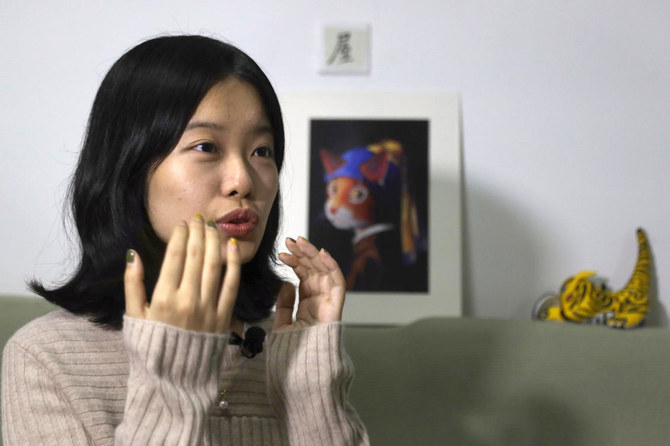When Wu Ke-xi was looking for a frightening plotline for her latest film, she didn’t need to look further than her own industry.
The Taiwanese actress and screenwriter’s latest movie, “Nina Wu,” is the story of an actress who, in pursuit of a role that will lead to stardom, is abused and psychologically scarred by a man in power.
Wu found herself closely following the #MeToo movement in Hollywood, and decided to write something for women affected by sexual assaults in the entertainment industry. Directed by Midi Z, it was selected to show at the Cannes Film Festival.
“After 2017, after the year the Harvey Weinstein stuff occurred, I read a lot of documents and interviews. I was so purely curious about what happened,” said Wu. She said she has been threatened in her career, but never sexually assaulted. “It’s still a humiliating experience,” she said.
“So I felt really connected to those women.”
Asia is having its own #MeToo moment, with its homegrown entertainment industries grappling with many of the issues that have upended entertainment careers in the United States and beyond.
Earlier this year, the K-pop scene was shaken when two male stars were accused of sexual misconduct in South Korea. Solo singer Jung Joon-young faced allegations he secretly filmed himself having sex with women and shared the footage on a mobile messenger app; he apologized to the victims. And Seungri, the youngest member of the quintet Big Bang, was accused of trying to steer sex services to business investors. He denied the charges and retired from the group.
Last year, in India, Bollywood actress Tanushree Dutta came forward with details of a 2008 complaint she filed against actor Nana Parekar for alleged sexual harassment, which he denied. A flood of stories of sexual harassment and assault followed on social media from Indian actresses and writers.
Indian actor, singer and filmmaker Farhan Akhtar, a United Nations “He For She” ambassador with his own “Men Against Rape and Discrimination” initiative, says there is unease in the industry.
“Fear runs down the spine of everyone, thinking that, ‘Oh my God, maybe I’ve done something in the past that might come back to bite me,’” he said.
He encourages other women to come forward and speak out.
“Nobody can do it for her. Nobody can out her story and put her in a position that maybe she doesn’t want to be in,” he said. “But when she does, then it’s important that people rally around her so that she feels she’s done the right thing. And through her, through that conversation, and through her words she will hopefully inspire, motivate many more people to come out. And that’s the way the system will be cleaned.”
Screenwriter Zhou Xiaoxuan did speak out. She became a central figure in China’s #MeToo movement after an essay she wrote privately, claiming she was sexually assaulted by a TV star, went public on the social media platform Sina Weibo last summer. A prominent television host, Zhu Jun, sued her for defamation and Zhou followed with her own suit, for infringing on her personal rights. Women’s rights advocates in China are following the case.
Zhou says the movement has only reached so far in China, affecting mostly a group of high-profile, well-connected men.
“They were frightened by the #MeToo trend and they stopped. But most people in this society, they’ve never heard of #MeToo,” she said.
“I’ve actually been lucky because Zhu Jun is well-known,” Zhou said. “It’s extremely difficult for women who have been assaulted by their friends, colleagues or partners to seek legal recourse.”
Japanese TV journalist Shiori Ito said she experienced months of trolling and shaming after she revealed in May 2017 that she had been raped. That was before the #MeToo movement got under way in the United States.
“I’m very grateful to all the other women that have spoken up because I felt very lonely,” she said. She said she has felt a change in Japan and in her own family “who were really against me speaking up, and then they started saying, ‘You know what, maybe she’s right.’“
An emotional television interview with South Korean prosecutor Seo Ji-hyun in January 2018, in which she said she had been assaulted eight years earlier, is credited with starting the #MeToo movement there. Seo has since won a court case for abuse of power against her alleged assaulter. She said that watching women reveal their stories in Hollywood helped give her the courage to speak publicly. Supporters marched in the streets with candles and #WithYou banners.
“I told myself that, ‘Yes, this was not my fault and that I should not be ashamed at all,’” she said.
In Pakistan, dancer, theater director and activist Sheema Kermani is campaigning against sexual abuse, trying to make the movement there more than a moment.
“When actresses, big actresses, started calling out big names of actors for sexual harassment, I think it gave Pakistani women and women in media . the courage to speak out,” she said.
In Thailand, model and TV personality Cindy Sirinya Bishop launched the “Don’t Tell Me How To Dress” campaign after receiving a wave of support for a “social media rant” — her response to an article advising women not to wear sexy clothes for the Thai New Year in order to avoid sexual assault.
“It all started when that clip that I posted went viral overnight with the support of many, many women all over Thailand, chiming in, commenting, sharing and saying ‘Yes, this is exactly what we feel.’ Why are we always the ones that have to cover up, or why, when we are harassed or assaulted, is it somehow our fault?” she said.
Bishop also created an exhibition displaying clothing worn by sexual-assault victims. “We have university student outfits to toddler’s clothing to sweatpants and T-shirts,” she said.
She says her movement would have happened regardless of the stories arriving from America. But she adds: “In some way, the #MeToo movement has collectively empowered women without our knowing it, all over the world.”
Asian entertainment industries grappling with #MeToo issues
Asian entertainment industries grappling with #MeToo issues

- Asia is having its own #MeToo moment, with its homegrown entertainment industries grappling with many of the issues
- “Nina Wu,” is the story of an actress who, in pursuit of a role that will lead to stardom, is abused and psychologically scarred by a man in power
Used missiles for sale: Iranian weapons used against Israel are up for grabs on Jordan-based website
Used missiles for sale: Iranian weapons used against Israel are up for grabs on Jordan-based website

- Debris used in attack listed on OpenSooq online marketplace
LONDON: Fragments of missiles launched by Iran during the recent attack on Israel have been discovered for sale on Jordan’s prominent OpenSooq website, which is known for trading goods, including vehicles and real estate.
Al Arabiya reported on Sunday that the shrapnel was being advertised, with pieces described as “Used Iranian ballistic missile in good condition for sale,” and “One-time use ballistic missile for sale at an attractive price.”
The sellers had provided specifications and images of the missiles, describing them as “excellent type,” and mentioned their involvement in an “accident” resulting in “severe damage to the body.”
Some listings even included installment payment options.
Iran launched drones and missiles toward Israel late on Saturday as it retaliated following a suspected Israeli strike on the consulate annex building adjacent to the Iranian Embassy in Damascus, Syria, earlier this month.
While most projectiles were intercepted by a joint response from Israel, the US, UK, France, and Jordan, the attack marked Iran’s first direct military assault on Israeli territory, escalating tension and uncertainty in the region.
Following the attack, individuals shared photographs online showing debris that had fallen on Jordanian territory in areas such as Al-Hasa, Marj Al-Hamam, and Karak Governorate.
The Jordanian government confirmed that it had intercepted some flying objects in its airspace, with no reported damage or injuries.
Debris from such incidents often holds economic value. Metal debris from the Iraq War has been used by Iran-backed groups to finance their activities.
Similar items are sold online as military memorabilia, and there has been a surge in demand for such artifacts, as seen in Australia last year, preceding the country’s ban on the sale of hate symbols.
Google Doodle celebrates Lebanese-American poet and artist Etel Adnan

- Etel Adnan rose to fame for her 1977 novel Sitt Marie Rose about the Lebanese civil war
DUBAI: Google released its latest Doodle on Monday honoring Etel Adnan, a Lebanese-American poet, essayist and visual artist, considered one of the most accomplished Arab-American authors of her era.
The poet, who rose to fame for her 1977 novel Sitt Marie Rose about the Lebanese civil war, was born in Lebanon in 1925 to a Greek mother and a Syrian father, and grew up in multiple cultures, languages, nationalities and religions. Sitt Marie Rose won the France-Pays Arabes award and become a classic of war literature, so much so that it is taught in American classrooms.
In 1949, Adnan went to Paris to study philosophy at the Sorbonne before going to America to study at Harvard and Berkeley.
From 1958 to 1972, she taught philosophy in California, during which time she also started painting and writing poetry. She developed her literary voice in English and said abstract painting was the entry point into her native Arabic.
Adnan returned to Beirut, where from 1972 to 1976 she worked as the arts editor for two newspapers. She returned to California in 1979, then spent her later years living between Paris and Beirut.
In 2003, Adnan was named “arguably the most celebrated and accomplished Arab American author writing today” by the academic journal MELUS: Multi-Ethnic Literature of the United States.
Adnan’s most recent honor was in 2020. Her poetry collection “Time,” which is a selection of her work — translated from French by Sarah Riggs — won the Griffin Poetry Prize.
The King Abdulaziz Center for World Culture, or Ithra, earlier this year opened an eponymous exhibition in her honor – “Etel Adnan: Between East and West” – showcasing 41 of her works. The space at Ithra’s gallery is the first solo exhibition of Adnan’s work in Saudi Arabia, running until June 30.
The works on display span from the beginning of Adnan’s artistic career in the late 1950s through to her final creations in 2021, shortly before her death that year aged 96.
Some of the works are on loan from significant international institutions such as the Sharjah Art Foundation, Sfier-Semler Gallery and Sursock Museum. Some are part of private collections.
‘HELP’ written in palm fronds lands rescue for Pacific castaways

- The trio became stranded on Pikelot Atoll, a tiny island in the remote Western Pacific, after their motor-powered skiff malfunctioned
- A US Navy aircraft saw the "help" sign and a ship came later to rescue the stranded trio, all experienced mariners in their 40s
LOS ANGELES: Sometimes all you have to do is ask for “HELP“: That’s what three men stranded on a deserted Pacific island learned earlier this week, writing the message in palm fronds which were spotted by US rescuers.
The trio, all experienced mariners in their 40s, became stranded on a lonely island after setting off from Micronesia’s Polowat Atoll on March 31 in their motor-powered skiff which subsequently experienced damage.
They were reported missing last Saturday by a woman who told the US Coast Guard her three uncles never returned from Pikelot Atoll, a tiny island in the remote Western Pacific.
“In a remarkable testament to their will to be found, the mariners spelled out ‘HELP’ on the beach using palm leaves, a crucial factor in their discovery,” said search and rescue mission coordinator Lt. Chelsea Garcia.
She reported that the trio was discovered Sunday on Pikelot Atoll by a US Navy aircraft.
“This act of ingenuity was pivotal in guiding rescue efforts directly to their location,” she said.
The aircraft crew dropped survival packages, and rescuers one day later dropped a radio which the mariners used to communicate that they were in good health, had access to food and water, and that the motor on their 20-foot (six-meter) skiff was no longer working.
On Tuesday morning a ship rescued the trio and their equipment, returning them to Polowat Atoll, the Coast Guard said.
In August 2020, three Micronesian sailors also stranded on Pikelot were rescued after Australian and US warplanes spotted a giant “SOS” they had scrawled on the beach.
Dining hall with Trojan War decorations uncovered in ancient Roman city of Pompeii

- One fresco depicts Paris and Helen, whose love affair caused the Trojan War, according to classical accounts
- Pompeii and the surrounding countryside was submerged by volcanic ash when Mount Vesuvius exploded in AD 79
ROME: A black-walled dining hall with 2,000-year-old paintings inspired by the Trojan War has been discovered during excavations at the Roman city of Pompeii, authorities said on Thursday.
The size of the room — about 15 meters long and 6 meters wide — the quality of the frescoes and mosaics from the time of Emperor Augustus, and the choice of characters suggest it was used for banquets, Pompeii Archaeological Park said.

“The walls were painted black to prevent the smoke from the oil lamps being seen on the walls,” Gabriel Zuchtriegel, head of the park, said.
“People would meet to dine after sunset, and the flickering light of the lamps had the effect of making the images appear animated, especially after a few glasses of good Campanian wine.”
Pompeii and the surrounding countryside was submerged by volcanic ash when Mount Vesuvius exploded in AD 79, killing thousands of Romans who had no idea they were living beneath one of Europe’s biggest volcanoes.
The site has seen a burst of archaeological activity aimed at halting years of decay and neglect, largely thanks to a 105-million-euro ($112 million) European Union-funded project.

The dominant theme of the newly discovered paintings is heroism and fate.
One fresco depicts Paris and Helen, whose love affair caused the Trojan War, according to classical accounts. Another one shows doomed prophetess Cassandra and the Greco-Roman god Apollo.
According to Greek mythology, Cassandra predicted the Trojan War after receiving the gift of foresight from Apollo, but no-one believed her. This was because of a curse Apollo put upon her for refusing to give herself to him.
Bosnian Formula One fan brings speed dreams to the mountains

- The 36-year-old mechanic bought the car from another racing superfan in the capital Sarajevo last year
- Since purchasing the vehicle, he has been methodically making tweaks to its exterior, while nursing hopes of one day replacing its engine
KLJUC, Bosnia and Herzegovina: Far from the glitzy racetracks where legendary drivers made their mark in the world of Formula One, Himzo Beganovic has turned his dreams of speed into reality along the dirt roads of northwestern Bosnia.
“I always wanted to own a Formula One car, to have it in front of the house, to be able to go for a spin,” Beganovic told AFP, as he tuned up a replica “Ferrari red” race car outside his home near the Bosnian town of Kljuc.
The 36-year-old mechanic bought the car from another racing superfan in the capital Sarajevo last year.
The replica, which took two years to build, remains a ramshackle mock-up, crafted with sheet metal — a far cry from the advanced carbon fiber used in the multimillion-dollar cars of Formula One teams.
Despite Beganovic’s limited means, he still hopes to make his car more efficient, bit by bit.
Since purchasing the vehicle, he has been methodically making tweaks to its exterior, while nursing hopes of one day replacing its engine.
Along with a more powerful motor, Beganovic hopes to install an automatic gearbox and better tires.
“When you drive Formula One, you feel like you are flying. It is not like a car,” he said.
“It is the only one in Bosnia-Herzegovina. There are no others.”
A self-professed lover of “fast driving” and taking “dangerous turns,” Beganovic has been turning heads along Bosnia’s mountain roads where he reaches speeds of up to 200 kilometers per hour (124 miles per hour).
Other times he simply parks the car in a popular area and lets people check it out.
“I sometimes put it on a trailer to take it to other places in the country. People come, photograph it, and ask questions,” he said.
“The feeling is indescribable.”
For Beganovic, there was no question of what color the car would be.
As a longtime fan of seven-time world champion Michael Schumacher, the Ferrari-red paint pays tribute to the driver who won five titles with the famous Italian team.
Since the legendary German champion’s skiing accident in 2013 in the French Alps, Beganovic said he has yet to find another driver that interests him as much.
With Schumacher in mind, he hopes to put an Audi V-8 engine into his car soon.
“When a German engine and Bosnian ingenuity combine, you get an Italian car,” laughed one of Beganovic’s neighbors.




















